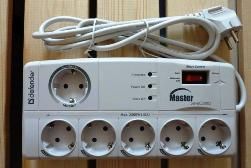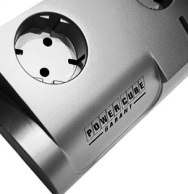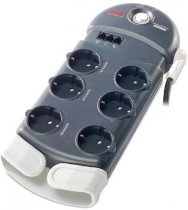Categories: Interesting electrical news, Electrical Reviews, How does it work
Number of views: 103287
Comments on the article: 13
How network filters are arranged and work
Network interference as they arise. Network filter device, the purpose of its elements. Features of network filters.
 Question theory
Question theory
Alternating current in a household network is sinusoidal. This means that changes in voltage, and, consequently, in current, occur along a sinusoid, that is, along a smooth arc oscillating symmetrically around the time axis. In one second, the voltage in the outlet changes its value from +310 to -310 volts fifty times. So, in theory, an AC network of 220 volts 50 hertz works.
However, if we look at the voltage waveform in our outlet, we will see that it is far from ideal. What is there a sinusoid !? Continuous peaks, impulses, shape distortions, amplitude changes, throws and jumps - this is what we will see. All this very spoils the picture and is able to disable household appliances. The latter, first of all, relates to music centers, televisions, power supplies for radiotelephones and other devices.
There are many reasons for distortion of the sinusoid of the mains voltage. These include turning on and off powerful electric receivers, atmospheric overvoltages, short circuits on the high side of a transformer substation, as well as various complex transients.
From a course in mathematics it is known that any complex function can be represented in the form of a converging trigonometric Fourier series. This means that our distorted sine wave is simply the sum of other, very different sine waves, each of which has its own frequency and amplitude. And for us, for the safe and reliable operation of our household appliances, we need to leave only one sinusoid - with an amplitude of 310 volts and a frequency of 50 hertz. All other sinusoids or, as is customary to say, harmonics we need to suppress, discharge and not pass to the power receiver.
In addition, there is also a special type of aperiodic interference that cannot be predicted or described using mathematical functions. These are impulse surges - very short-term, but significant increases. They can occur absolutely at any moment of time and, of course, also do not benefit household appliances. Therefore, impulse noise must also be suppressed.
 To solve these two problems and are used network filters. They protect equipment from high frequency, low frequency and impulse noise in the network. But how do they work?
To solve these two problems and are used network filters. They protect equipment from high frequency, low frequency and impulse noise in the network. But how do they work?
Surge protector
If the resistance of the resistors does not depend on the type of current passing through them, then the reactance of such circuit elements as capacitance and inductance is directly dependent on the frequency of the current. For example, the resistance of an inductor rises sharply for high frequency currents.
This inductance property is just used in surge protectors to suppress high-frequency noise - sine waves with small periods. It is enough to place two coils in series with the load - in the neutral and in the phase conductor. The inductance of each may be approximately 60-200 μH.
Low-frequency interference can be suppressed by the active resistance of the inductors, or by individual resistors, which are also arranged in series with the load. The resistance of such resistors should not be large, otherwise they will have a significant voltage drop. Therefore, resistors for suppressing low-frequency interference must have a maximum resistance of 1 ohm.
However, the filters that carry the code name LC are most effective against network interference. They are not limited to inductors, and include a capacitor with a capacity of 0.22 - 1.0 μF, connected in parallel with the load.The rated voltage of the capacitor must be selected with at least two margins relative to the mains voltage in order to take into account the differences in this voltage.
The effect of LC filters is directly related to two switching laws: a coil L suppresses sudden changes in current, and a capacitor C dampens high-frequency voltage fluctuations.
But we still have pulsed short-term interference. They can be dealt with using a special semiconductor element having a nonlinear current-voltage characteristic - a varistor. At low voltage, the varistor behaves like a resistor of very high resistance and practically does not pass current. But if the voltage rises to the nominal level for the varistor, then its resistance decreases sharply - it passes a current pulse through itself.
Thus, if the varistor is included in the parallel load, then it will "take over" high voltage pulses, shunting the load for the duration of their exposure. The rated voltage of the varistor should be about 470 volts.
 So, the line filter for more or less successful operation should contain: two inductors 60-200 μH connected in series to the protected load, as well as a 470 volt varistor and a 0.22 - 1.0 μF capacitor connected in parallel. If necessary, resistors can be included in the circuit to suppress low-frequency interference by 1 Ohm maximum. The current rating of the circuit elements must be selected depending on the load power.
So, the line filter for more or less successful operation should contain: two inductors 60-200 μH connected in series to the protected load, as well as a 470 volt varistor and a 0.22 - 1.0 μF capacitor connected in parallel. If necessary, resistors can be included in the circuit to suppress low-frequency interference by 1 Ohm maximum. The current rating of the circuit elements must be selected depending on the load power.
Practice
The vast majority of cheap network filters that we know in everyday life, in fact, are not network filters. They contain only a varistor and a bimatallic contact for maximum current protection.
But such filters are easily refined if arm with a soldering iron and collect all the necessary listed items to assemble the LC circuit.
The power of most surge protectors is low. This is due to the fact that inductors and other filter elements for heavy loads will be too bulky and expensive. Often, for power receivers of high power in general, only filters that are semiconductor converters can be used. And the price of such filters will be much higher, as well as the complexity of their device.
Fortunately, powerful household electrical appliances do not need to be protected from network interference. And the stove, and the iron, and the kettle absolutely do not care about the quality of the electricity they receive. Therefore, they do not need surge protectors.
And computers, televisions, and music centers consume very little energy, and a separate line filter with a rated current of just a few amperes is enough to protect them.
Alexander Molokov
See also at e.imadeself.com
:
